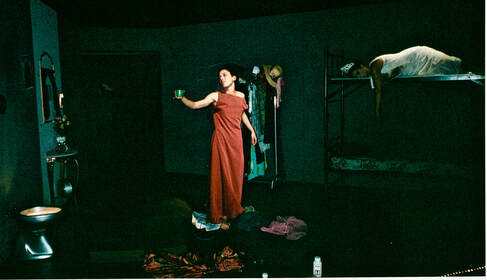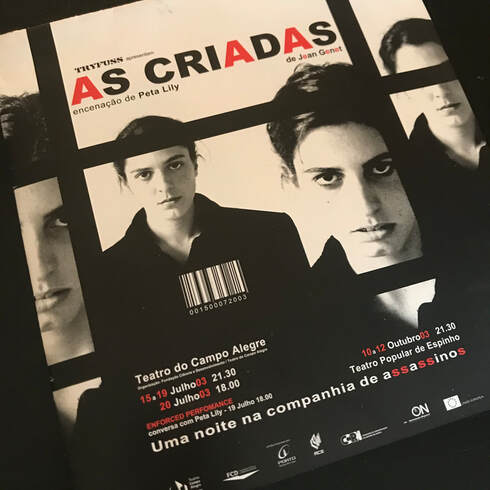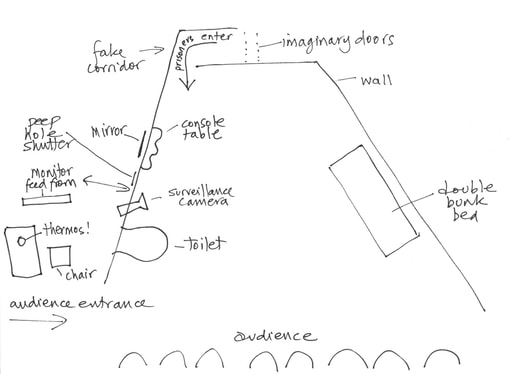 Scene from the end of the adapted play - one girl poisoned and the other about to drink the tea ... in the red dress is Inez Lua, wearing the tiara is Micaela Miranda
Scene from the end of the adapted play - one girl poisoned and the other about to drink the tea ... in the red dress is Inez Lua, wearing the tiara is Micaela Miranda I was approached by the remarkable performing artist Ines Lua to direct a production of Jean Genet's play The Maids in Oporto, Portugal in 2003.
Playwright Jean Genet wished for the play to be performed by men. Here I would have three attractive young women to play the two maids and their employer, Madame. Although there is plenty of self-loathing in the play, there are also evening gowns and maids uniforms and I wanted to avoid any possibility of the audience's attention being de-railed from the bleakness of the situation portrayed. So I thought - Enforced Performance is the way!
I was introduced to the writing of Jean Genet when I was seventeen and a strong imprint was made. Genet inspired me with his underdog stance and his aesthetic of degradation. For those who do not know, Jean Genet was wrongly accused of theft when he was a boy in foster care. He decided that he would make the active choice to live as a thief, and wrote a long-form poem and a novel while in prison. He sought out and introduced himself to Jean Cocteau, who was impressed by Genet's writing and not only got Genet's first novel published, but, enlisting the help of Sartre and Picasso, petitioned the French President to save Genet from life imprisonment. Genet never returned to prison and spent the rest of his life as a writer and as a political activist. Theatre maverick Lindsay Kemp created his production Flowers, inspired by Genet's novel Our Lady of the Flowers.)
I offered my concept to Ines Lua and Micaela Miranda (co-producers) - that the piece be set in a women's prison. They, and the actor playing Madame (Lecoq-trained actor Sandra Salome) agreed.
Play within a play
When the Marquis de Sade was confined within the asylum Charenton, he was permitted to create plays using the inmates, to which members of the public were invited, as memorably explored in Peter Weiss' play 'Marat/Sade: The Persecution and Assassination of Jean-Paul Marat as Performed by the Inmates of the Asylum of Charenton Under the Direction of the Marquis de Sade.'
Of course, setting something in a location (or time period) is not enough - you need a clearly articulated and delivered game. So - imagine a regime* presents plays for the public, performed by actual prisoners. For the prisoners, first night nerves combine with the humiliation of public scrutiny, plus uncertainty - what will happen if they do not perform well? Backstory: female cellmates are separated and rehearsed separately.
I had to check with the young company as to their budget, because performing in a black box would not do - we needed the audience to be presented with a space they (the audience) could believe (with the support of suspension of disbelief) was as secure as a prison space. Their set designer came up with an ingenious solution: there would be two angled walls, and a flat as a back 'wall'. The soundscape would provide loud metallic door slams to make viewers believe that unseen doors could be opened to admit the prisoners onto the stage area, and securely slammed and locked behind. All the furnishings - a bunk bed SL, a lidless toilet SR would be clearly bolted to the grey walls which were painted to appear sturdy. Also clearly bolted to the SR wall was a shallow little belle époque console, and above that a gilt-framed oval 'mirror' (just the frame, as a mirror could of course be broken and used as a shiv). There was a peep-hole which connected to the guard's station and above that a surveillance camera pointed into the cell and streaming live feed to a monitor visible above the guard's desk. See below for a space plan.
The audience would enter past a guard. She had a tiny office or station just inside the theatre doors. She would solemnly nod at them, perhaps frisking the odd person or asking to see inside their bag. (Ideally she could have also pointed at a poster saying 'Do not speak to or hand anything to the prisoners', but we did not have the resources to do everything, and what we had worked well enough).
A little bit of Implicating the Audience
As the lights lowered there were musical theatre announcement chimes, then a soft and pleasant voice said: 'Good evening, Ladies and Gentlemen. The performance of "The Maids' by Jen Genet is about to begin. If your mobile phone rings during the performance, the actors will stop - and wait for you to finish your call. Alternatively, you can opt to switch off any electronic beeping device. Thank you. Please remain seated for the Security Test.' This was followed by a a loud sound of crackling electricity - lights flickered, and an orange lighting strip embedded into the floor blinked - all giving the illusion of a kind of electric forcefield between stage action and auditorium. 'Teste de segurança terminado.** Attention guards, open the doors.'
Black out lights up and loud airhorns, the sound of batons thumping along corridor walls, doors opening and closing*** (rhythm) and a female prisoner in an unattractive uniform (I think we chose a kind of catering uniform), arrives on stage as if she has been shoved - staggering and falling. She orients herself - bright lights, she sees the audience, feels self-conscious, looks about in disbelief (clear clocks) at the replica of her old cell presented as stage set. A second prisoner is also thrust out, less violently.
High Stakes
The two prisoners regard each other - the horror of being surveilled - by the guard SR, by the audience. Imagine the way prisoners look at each other when they are being watched, careful not to endanger themselves or each other. In torture realms, uncertainty is part of the torment. You are never sure what the rules are, what the duration of time will be, what will be coming next. The trope of embarrassed non-activity at the start of a show has been done beautifully by a number of clowns (and Beckett) ****.
Here their anxiety is ramped, their breathing is activated. Their eyebrows are each telegraphing each other - immobilised, as if in a Mexican standoff. The second prisoner (Micaela/Claire) makes a gesture of urgency to her comrade. Ines/Solange is looking intently back at her, after all, Claire has the first line. So Micaela/Claire resigns herself to speak, in anguish: 'Those gloves! those eternal gloves!' Ines/Solange starts, looks at her bare hands, panics, looks at the audience, then sees, laid out along the front of the stage a row of plastic bags - like evidence bags in a police station, the props for the play are contained within them. Ines/Solange flings herself to her knees, crawls back and forth urgently along the front until she finds the correct bag, claws it open and frantically tries to get on the rubber gloves. The fingers are not fitted right and flop about. (real emotion plus touches of the ridiculous). 'Everything that comes out of the kitchen is spit.' Ines/Solange is nervous (the prisoner playing Solange is not a trained actor*****) and on reflex, she spits onto the floor. Horror for Micaela/Claire. The classic clown trope of problem -solution leading to new problem - leading to new solution ad infinitum; the Clown's Sisyphean predicament. Ines/Solange starts to scrub frantically to clean it. 'So stop it!' By reflex, and in keeping with the principle of comedy nudges, Ines/Solange does one more scrub. 'Go!' Ines/Solange, has a problem ... there is no escape - she clocks the audience, the surveillance video, the entrance (which leads back to the cells and which is sealed now) She solves the problem ... by standing with her face to the wall.
Two lines were cut but, we follow Genet's stage direction where Micaela/Claire goes to the 'mirror' and touches the unfamiliar and absurd dressing table and the fake, securely attached flowers in the securely attached vase. (We played Claire as more vulnerable, traumatised, given to hypnotic moments. Ines as Solange had a vigorous, nervous, courageous, protective quality).
Micaela now must say the lines 'Claire, Claire are you there?' as if her fellow player were not in view.*****
At this moment we had the prison guard (Sandra Salome) shunt open the peephole (it makes a sound). Ines/Solange is startled as the slit is right in front of her and she is eye-to-eye with the guard.
Sandra/Guard (stage whisper): 'Turn. Around.' Hesitating, Ines/Solange does so and Micaela/Claire says: 'Ah, you're back.' (For Ines/Solange this is a playing moment similar to the disorientation played by Pedrolino in Commedia dell'Arte, when everyone is pretending that he is dead).
... and so forth. Important at the start to a/ clearly establish the situation and b/ create some comedy using contrast, rhythm, clocking etc.
Believable yet exaggerated
The Prison Guard had an old-school cartoon-jailor-style large ring with keys around her waist. Her costume had a pleated skirt, like some ghastly headmistress.
She also has a thermos - I must have seen a film where a petty official had a thermos on their desk. (I's an intuitive choice - but if I seek to elaborate - although she is obnoxious it also brings a feeling of; she's harmless. Or does it? Somehow the thermos is creepy. She is too comfortable with her thermos - the obscenity/chilling reality that a jobsworth is a figure of power ... the banality of evil). The Controller in Hamlet or Die had a thermos. (Spoiler alert: beyond being a predilection of mine, the thermos turns out to have plot ramifications.)
Plot Twist - use everything
So the prisoners are reciting the play, performing it as best they can - they notice at one point that that surveillance camera is off - they investigate and realise that these are their actual, usual bunkbeds. They start to hunt in their hiding places and discover a vial of pills.
The Madame is due to return - guess who it is? The prison guard. She wears a wig hat and feather boa over her uniform. She suspects something is up and is violent with the prisoner playing Solange, pushing her around and forcing her head into the open toilet bowl. A beautiful red satin dress also gets pushed in to the toilet later in the play.
The plot of Genet's play has the sisters doing a role-play ritual that is intended to end with the death of one of them, via the preparation of a poison tea. In this version of the play, they sisters manage to place the drugs in Madame's thermos (she carries it with her, of course).
Follow through
Madam realises something is up and makes the prisoner playing Claire drink the tea. The guard leaves.
Death is here and she is watching us.' says Solange.
'Let me go', says Claire.
Micaela/Claire takes to her bunk.
Solange continues, distraught - a moment comes when there is no reply. Solange repeats her line, waits then says (inserted line) : 'don't worry darling, I'll do your part.'
Solange finishes the play, reciting both parts, poignantly.
C: Let's finish with this, Solange. I can't bear it anymore. Leave me alone.
S: I shall continue, on my own, alone my dear? Don't move .... (she clock that by now Claire is completely inert ... but continues - out of grief, out of fear, out of divine hopelessness?
The prisoner playing Solange tears off her prison uniform and strips to her knickers.
During the 'condemned to be mourning for my maid' speech she goes to the toilet, retrieves and puts on the damp red dress mentioned in the text: 'It's the red costume of criminals' ...
She is looking at the audience in disbelief as they continue to watch.
One evening Ines was having difficulty getting the red dress on and lost her way in the text and she started improvising. She looked at the audience, really eyeballed them across the now gently glowing 'force field' strip. It was brilliant!
'Oh you think it's funny do you? You sitting there in your seats and me here in my knickers!'
She used some of Genet also: ''Who, who is going to make me shut my mouth up? Who will be brave enough to call me "my child" ... I served. I did the appropriate gestures to serve. ...I smiled at you ... I bent over to clean the floor' (these sections of text wonderfully appropriate to our adaptation), ending Solange's soliloquy with: 'We are lost, Clara'.
And continuing, the dialogue all being spoken by the sole survivor.
'Clara you may serve the tea ... My lime tea, I ordered you, Let's finish with this ... this house is poisoned ...'
And she finds the damn thermos and drains it and licks the inside of the cup top, continuing: 'Madame should have her Lime tea ... Madame is having her Lime tea ... for she needs to sleep ... don't you interrupt me again ...But madame ... I said, Tea!'
And she crawls onto the bunk, spooning her dead fellow prisoner.
Leaving it in their laps
Announcement by the same sweet-toned female voice at the start, a little more firm and official sounding now :
Ladies and Gentlemen, a peça terminou ... the play is finished. Please leave the vicinity. Thank you for choosing our play and good night.
Black out.
* hm, one of the things that bothered me about Bouffon was that is was meant to poke fun at the beautiful people - I guess this model works where upperclass (wealthy) people are in the audience. In my experience of Fringe theatre there will be a good amount of your audience who are other performers (i.e. not really a privileged class) - of course we can all benefit by having our faults and privileges mocked. I wonder if this is why the idea of 'enrolling the audience' appeals to me. Jon Davison came and witnessed day two of my Clown & Dark Clown course years ago and said - 'so you put the audience in the role of the oppressors'. I was not sure at the time that that was correct, or possible. I feel that an audience know who they are - they are the ones who paid for their ticket and then walked in. Someone has to accept a role to play it, I thought. But perhaps what Jon meant was simply ascribing them this role, not synonymous with asking them to play the role. You can jolly audiences in to taking part, as many clowns and cabaret artist do. (Or entrance them into taking part as Lucy Hopkins did in her transcendent show 'Ceremony of Golden Truth').
As I reflect on the dramaturgy of this production of The Maids and also Hamlet or Die, I went to efforts to let the audience know what the situation was. The audience find themselves 'cast' as an audience witnessing oppression for their entertainment. It is not that I wish place the audience in the role of perpetrator. No. I aim for the audience to find themselves in a situation which they find unsettling and repugnant - and while they know it is 'only a play', due to the 'suspension of dis-belief' effect' they can experience conflicted emotions ('I witnessed it therefore I am complicit' or, as happened in Hamlet or Die 'I sang along with the Controller and afterwards I felt so bad.')
**actually, the whole play was performed in Portuguese. I can find no translation in English that satisfies as much as the use of the word 'terminado'.
***actually, on a page of notes for the sound designer I see I have written very specifically: 'aruga aruga (2 secs gap) aruga aruga (2secs gap) aruga aruga (2secs gap) aruga argua aruga argua aruga argua SLAM!!!!)
****The wonderful Australian clowns Los Trios Ringbarkus spoke with nervous high-pitched voices: 'Our band hasn't arrived yet ... so ... we'll wait.' And they got chairs and sat and faced the audience uncomfortably.
*****The actor acts a prisoner who is not an actor, trying to act the role of Solange, currently in role as her sister 'Claire' - phewph.


 RSS Feed
RSS Feed
